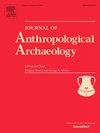Raised from the ashes: Geoarchaeological perspectives on house burning practices in an Iberian Iron Age village
IF 2.2
1区 社会学
Q1 ANTHROPOLOGY
引用次数: 0
Abstract
Burnt houses are a recurrent phenomenon in the prehistoric archaeological record, yet the specific processes behind their burning—likely varying across time and place—remain poorly understood. This study focuses on a thoroughly studied dwelling (House 1) from the Iberian Early Iron Age settlement of Cerro de San Vicente and investigates site formation processes associated with its burning. To achieve this, we applied a multi-proxy geoarchaeological approach, integrating archaeological soil micromorphology—including charcoal analysis on thin sections—, magnetic properties analyses, XRD, XRF, and GIS-based morphological and spatial analyses of mudbricks. Our results suggest that House 1 experienced a high temperature fire, reaching temperatures of up to ∼700 °C, which destroyed its roof, burnt its walls, and generated an ash deposit rich in combustion residues. Shortly thereafter, the house was deliberately infilled with burnt reused mudbricks, recycled both from its dismantled walls and potentially other buildings across the settlement. This practice likely served to raise the level of the house to compensate for midden accumulation in the surrounding transit areas while providing a foundation for new construction phases. These findings suggest that construction materials were reused over time according to context-specific cultural rationales, potentially reflecting elements of a prehistoric circular economy. This research enhances our understanding of settlement and socio-cultural dynamics at Cerro de San Vicente, while contributing to broader archaeological discussions on the roles of prehistoric house burning practices.
从灰烬中升起:伊比利亚铁器时代村庄房屋焚烧实践的地质考古学观点
烧毁的房屋在史前考古记录中是一个反复出现的现象,然而它们燃烧背后的具体过程——可能随着时间和地点的不同而变化——仍然知之甚少。这项研究的重点是彻底研究了伊比利亚早期铁器时代Cerro de San Vicente定居点的住宅(House 1),并调查了与其燃烧相关的遗址形成过程。为了实现这一目标,我们采用了一种多代理地质考古方法,将考古土壤微形态(包括薄片上的木炭分析)、磁性分析、XRD、XRF和基于gis的泥砖形态和空间分析结合起来。我们的研究结果表明,1号房子经历了一场高温火灾,温度高达~ 700°C,破坏了屋顶,烧毁了墙壁,并产生了富含燃烧残留物的灰烬沉积物。此后不久,房屋被故意填充了燃烧过的再使用泥砖,这些泥砖是从拆除的墙壁和整个定居点的其他建筑物中回收的。这种做法可能有助于提高房屋的水平,以弥补周围交通区域的中间堆积,同时为新建筑阶段提供基础。这些发现表明,随着时间的推移,建筑材料会根据特定的文化原理进行再利用,这可能反映了史前循环经济的要素。这项研究增强了我们对Cerro de San Vicente定居点和社会文化动态的理解,同时有助于对史前房屋燃烧实践的作用进行更广泛的考古讨论。
本文章由计算机程序翻译,如有差异,请以英文原文为准。
求助全文
约1分钟内获得全文
求助全文
来源期刊

Journal of Anthropological Archaeology
Multiple-
CiteScore
4.00
自引率
11.10%
发文量
64
期刊介绍:
An innovative, international publication, the Journal of Anthropological Archaeology is devoted to the development of theory and, in a broad sense, methodology for the systematic and rigorous understanding of the organization, operation, and evolution of human societies. The discipline served by the journal is characterized by its goals and approach, not by geographical or temporal bounds. The data utilized or treated range from the earliest archaeological evidence for the emergence of human culture to historically documented societies and the contemporary observations of the ethnographer, ethnoarchaeologist, sociologist, or geographer. These subjects appear in the journal as examples of cultural organization, operation, and evolution, not as specific historical phenomena.
 求助内容:
求助内容: 应助结果提醒方式:
应助结果提醒方式:


